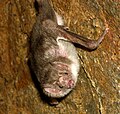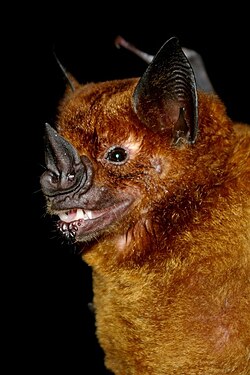Handley's nectar bat (Lonchophylla handleyi) is a species of bat in the family Phyllostomidae. It is found in Colombia, Ecuador, and Peru. Davalos, L.;...
1 KB (56 words) - 23:35, 21 November 2022
concava Dekeyser's nectar bat (Lonchophylla dekeyseri) Lonchophylla fornicata Handley's nectar bat (Lonchophylla handleyi) Western nectar bat (Lonchophylla...
36 KB (3,700 words) - 21:54, 1 June 2025
yellow-shouldered bat, great fruit-eating bat, white-lined broad-nosed bat, Pallas's long-tongued bat, Handley's nectar bat, white-bellied big-eared bat, greater...
12 KB (1,377 words) - 01:52, 23 June 2025
larger animals They were specialized nectar-feeders that evolved to feed on another type of liquid The vampire bat lineage diverged from its family 26 million...
38 KB (4,334 words) - 16:18, 9 June 2025
tube-lipped nectar bat (Anoura fistulata) is a bat from Ecuador. It was described in 2005. It has a remarkably long tongue, which it uses to drink nectar. It...
3 KB (363 words) - 21:11, 3 August 2024
spectral bat (Vampyrum spectrum), also called the great false vampire bat, great spectral bat, American false vampire bat or Linnaeus's false vampire bat, is...
31 KB (3,283 words) - 17:21, 23 June 2025
The Honduran white bat (Ectophylla alba), also called the Caribbean white tent-making bat, is a species of bat in the family Phyllostomatidae. It is the...
23 KB (2,783 words) - 20:36, 12 May 2025
The common vampire bat (Desmodus rotundus) is a small, leaf-nosed bat native to the Americas. It is one of three extant species of vampire bats, the other...
29 KB (3,144 words) - 01:54, 25 June 2025
long-nosed bat consumes nectar from the same plants as the southern long-nosed bat, the two species utilize different habitats. The greater long-nosed bat prefers...
11 KB (1,247 words) - 09:59, 8 June 2025
et al. (1993). "Flight speeds and mechanical power outputs of the nectar-feeding bat, Leptonycteris curasoae (Phyllostomidae: Glossophaginae)". Journal...
11 KB (1,218 words) - 08:43, 9 December 2024
Mexican long-nosed bats form the genus Leptonycteris within the leaf-nosed bat family Phyllostomidae. Like all members of the family, they are native to...
3 KB (147 words) - 08:19, 2 April 2024
Bokermann's nectar bat (Lonchophylla bokermanni) is a bat species from South America. It is endemic to Brazil. It feeds on nectar, and is listed as an...
7 KB (838 words) - 19:42, 22 November 2024
Pallas's long-tongued bat (Glossophaga soricina) is a South and Central American bat with a fast metabolism that feeds on nectar. It has the fastest metabolism...
4 KB (342 words) - 07:01, 25 June 2024
Goldman's nectar bat (Lonchophylla mordax) is a bat species found in Brazil, Colombia, Costa Rica, Ecuador and Panama. Sampaio, E.; Lim, B.; Peters, S...
1 KB (50 words) - 20:23, 12 August 2023
Peracchi's nectar bat (Lonchophylla peracchii) is a species of nectar-feeding bat in the family Phyllostomidae. It was first described from the Atlantic...
3 KB (244 words) - 13:14, 30 December 2023
Lonchophylla concava (redirect from Central American nectar bat)
from eastern Panama in 1912. In 1966, Handley published that L. concava was a synonym of Goldman's nectar bat (L. mordax); this was maintained until...
4 KB (433 words) - 08:21, 17 June 2025
The orange nectar bat (Lonchophylla robusta) is a species of bat in the family Phyllostomidae. It is found in Colombia, Costa Rica, Ecuador, Nicaragua...
2 KB (190 words) - 23:40, 21 November 2022
Thomas's nectar bat (Hsunycteris thomasi) is a bat species from South and Central America. Thomas's nectar bat pollinates the vine Marcgravia. Solari...
2 KB (98 words) - 12:56, 15 February 2023
large amounts of protein, nectar, pollen, flower pieces and a few insects. The maximum longevity for the Jamaican fruit bat is nine years in the wild...
19 KB (2,209 words) - 04:41, 22 May 2025
Dekeyser's nectar bat (Lonchophylla dekeyseri) is a bat species found in Brazil and Bolivia. This species was initially encountered in August 1970 in Brasília...
8 KB (976 words) - 19:37, 22 November 2024
Musonycteris.[citation needed] This bat is also a neotropical nectar-feeding bat (Phyllostomidae: Glossophaginae). Neotropical nectar-feeding bats comprise approximately...
13 KB (1,399 words) - 07:34, 26 May 2025
vegetation on St. John. The Antillean fruit-eating bat's varied diet includes fruits, pollen, nectar, and insects. Fruits consumed in the wild include...
5 KB (461 words) - 22:20, 12 August 2023
Handley's tailless bat (Anoura cultrata) is a species of bat in the family Phyllostomidae. It is found in Bolivia, Colombia, Costa Rica, Ecuador, Panama...
1 KB (61 words) - 21:58, 21 November 2022
The hairy-legged vampire bat (Diphylla ecaudata) is one of three extant species of vampire bats. It mainly feeds on the blood of wild birds, but can also...
11 KB (1,219 words) - 16:47, 22 June 2023
The red fruit bat or red fig-eating bat (Stenoderma rufum) is a species of bat in the family Phyllostomidae, in the monotypic genus Stenoderma. It is found...
8 KB (980 words) - 00:16, 28 May 2025
populations migrate south for the winter. The Mexican long-tongued bat feeds on nectar, pollen from agaves, and fruits from other plants. Its tongue can...
10 KB (1,057 words) - 20:16, 26 May 2025
variety in feeding habits than any other bat family. Carnivores, frugivores, and bats that specialize on blood or nectar and pollen are all represented in this...
14 KB (1,766 words) - 12:30, 28 April 2025
Lonchophylla (category Bat genera)
Lonchophylla fornicata Handley's nectar bat, Lonchophylla handleyi Western nectar bat, Lonchophylla hesperia Unexpected nectar bat, Lonchophylla inexpectata...
2 KB (160 words) - 22:25, 15 November 2024
variety of insects, fruit, nectar, and pollen, though a few will also eat birds, bats, and small mammals, and the three vampire bat species of the subfamily...
305 KB (7,070 words) - 01:20, 3 July 2025
The greater spear-nosed bat (Phyllostomus hastatus) is a bat species of the family Phyllostomidae from South and Central America. It is one of the larger...
8 KB (960 words) - 12:09, 14 September 2022


























